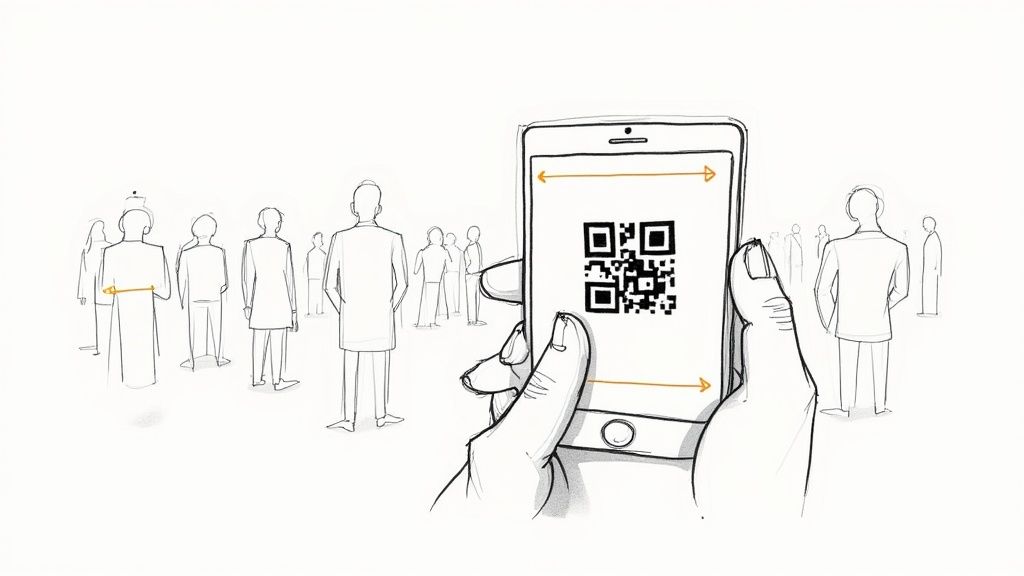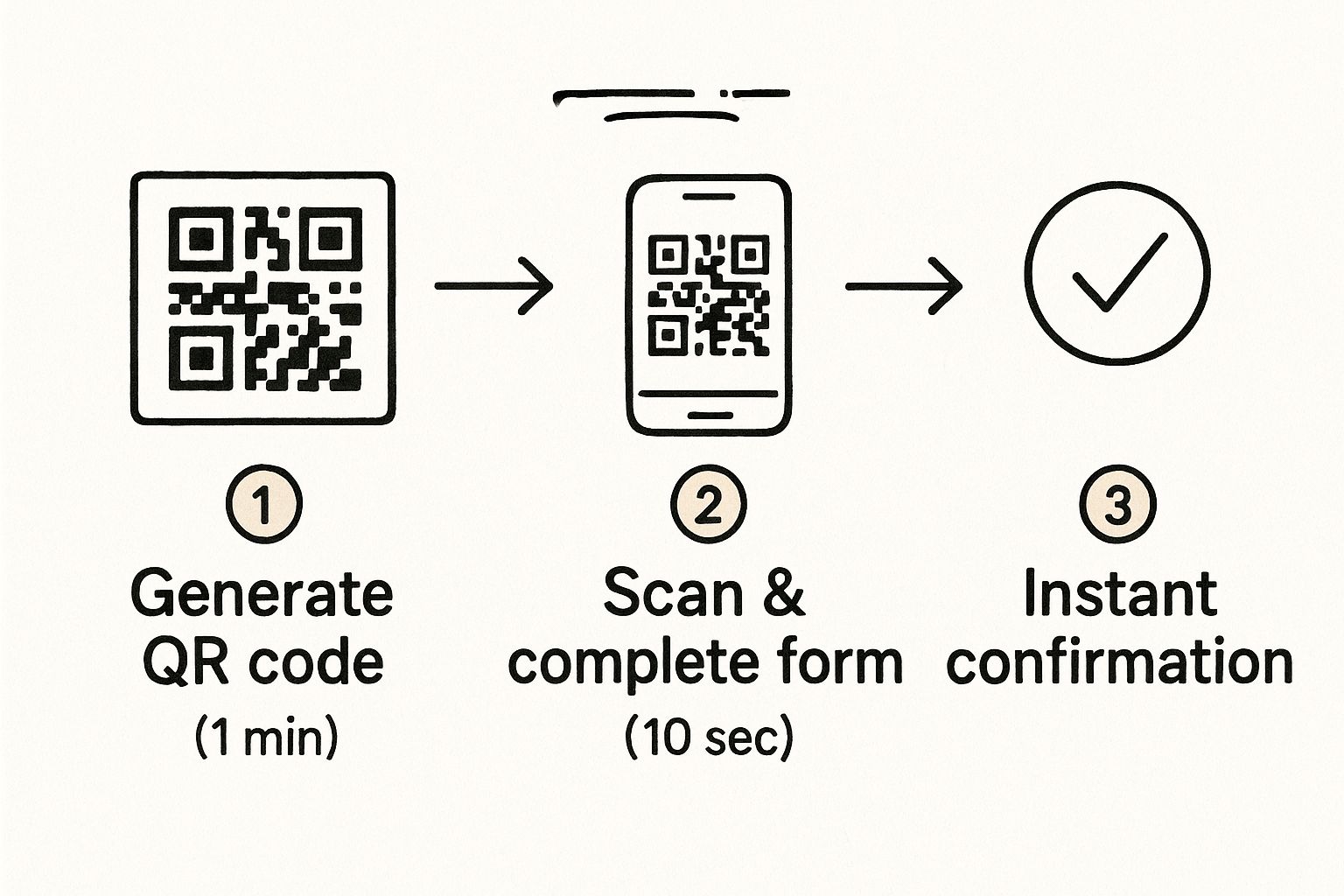August 22, 2025

QR code event registration is how you kill long check-in lines for good. It works by giving each attendee a unique, scannable code—essentially a digital ticket. They get it via email right after they register, and when they arrive, a quick scan with a smartphone or tablet gets them in the door. The whole process is fast, efficient, and completely paperless.

Let's be honest: long queues and messy clipboards are a thing of the past. QR code registration isn't just a cool gimmick anymore; it's a must-have for any event that wants to make a solid first impression.
The change is immediate. When you switch from manually checking names off a list to a simple scan, you crush wait times. You also cut down on paper waste and need fewer staff members tied up at the entrance. It's not just about convenience—it's about setting a professional, efficient tone from the moment your guests walk in.
The move to digital check-ins isn't slowing down. We've seen a massive surge in QR code use for event management, and by 2025, mobile QR code scanners are expected to hit over 100 million users in the US alone. This isn't a trend; it's the new standard. Using QR codes on event badges speeds up check-in, cuts down on human error, and gives you a live look at who's actually in the building.
Here’s a quick look at why this is so important for event planners.
This table breaks down the core differences between old-school manual check-in and a modern QR code system. It's a clear picture of how much more efficient and professional a digital approach can be.
As you can see, the advantages of a QR code system go far beyond just speed. It impacts everything from your budget to the overall vibe of your event.
This shift toward automation gives you a few key wins:
The first five minutes can make or break an attendee's entire experience. A slow, frustrating check-in starts things off on the wrong foot, and it's tough to recover from that. QR codes guarantee that first interaction is smooth, professional, and positive.
The first thing your attendees see is your check-in process, and it needs to be flawless. With a system like GroupOS, your staff gets a clean, simple interface where they can either scan a QR code or quickly look up an attendee by name if needed.
It's designed to be so user-friendly that even temp staff or volunteers can get the hang of it with almost no training. But getting people in the door quickly is just one piece of the puzzle. To really grasp the full impact, check out these 7 Surprising Benefits of a QR Code for Events. This kind of organized, tech-forward approach sends a powerful message about your event's quality right from the start.
Switching to a QR code system for your event registration might seem like a heavy technical lift, but with the right tools, it’s surprisingly simple. Honestly, it's less about complex setup and more about tweaking a few settings to give your attendees a really smooth, automated experience. You can go from a new event idea to a live, scannable registration in just a few minutes.
First things first, you'll create your event inside a platform like GroupOS. This is where you lay the groundwork—event name, date, venue—and then build out your ticketing. I’ve found it’s best to get specific here. You can create different tiers like "Early Bird General Admission," "VIP Access," or even a "Sponsor Pass." Each one can have its own price, capacity, and rules.
With your tickets sorted, the next step is to design the registration form. This is your chance to collect valuable data, but there's a fine line to walk. You need enough info to be useful, but not so much that you scare people away from signing up.
I always recommend sticking to the essentials at a minimum:
The great thing about a tool like GroupOS is the ability to add custom fields. For a tech conference I ran, we added "Job Title" and "Primary Area of Interest" to help us recommend specific sessions and connect like-minded attendees. Just make sure every field has a purpose.
This is where the real efficiency kicks in. The moment an attendee fills out your form and completes their purchase, the system takes over. It instantly generates a unique QR code that’s tied directly to their specific registration details. This isn’t some generic, reusable code; it’s a secure digital key for one person and one person only.
At the same time, the system fires off a confirmation email. Inside, the attendee finds all their ticket info and, most importantly, their personal QR code. This whole process eliminates the manual work of sending tickets and ensures every guest immediately has what they need to get in the door. A good QR code sign-in system is designed to handle all of this behind the scenes.
This visual really captures how seamless this is from the attendee's point of view.

As you can see, the entire check-in process can be over in seconds, completely changing the vibe at the entrance from chaotic to calm.
Automation is the heart of a great QR code system. The second a registration is confirmed, your attendee should have everything they need without your team lifting a finger. This lets you focus on putting on an amazing event, not getting stuck in an administrative swamp.
The final piece is prepping your on-site crew for check-in. The good news? You don't need to invest in a bunch of expensive, specialized hardware. Your team can just download the platform’s check-in app on their own smartphones or a few tablets.
When a guest arrives, a team member scans the QR code right from the attendee's phone (or a printed copy, for the old-school folks). The app verifies the ticket against your attendee list in real-time, marks them as "checked in," and that's it. It’s a simple, scalable process that lets you easily set up multiple check-in stations to crush long lines before they even start.

A smart QR code system does more than just get people through the door; it's one of your best tools for getting them to sign up in the first place. When you place QR codes strategically across all your marketing channels, you're building a direct bridge for potential attendees to register the second they feel a spark of interest. It's all about closing that gap between "that looks cool" and actually signing up.
Think about your physical marketing. A QR code on a conference poster, a flyer pinned to a coffee shop bulletin board, or even a direct mailer can turn a static ad into an interactive sign-up form. Someone sees it, scans it, and boom—they're on your registration page. No fumbling to type a URL or trying to remember the event name later.
This approach is just as powerful online. Embedding a qr code event registration link directly into your digital content can give your conversion rates a serious boost.
Here are a few places I've seen this work wonders:
By doing this, you're making registration an impulse decision, not a chore. And the data backs this up: a staggering 78% of event registration pages are now built with mobile users in mind. It's a clear signal that catering to people on their phones isn't optional anymore.
The goal is to remove every possible barrier between "I'm interested" and "I'm registered." A well-placed QR code is the most effective way to eliminate the friction that causes people to lose interest or forget to sign up later.
For any of this to work, your registration page must be perfect on a phone. A QR code that dumps someone onto a clunky desktop site they have to pinch and zoom is a dead end. From the moment they scan that code to the second they get a confirmation email, the entire experience needs to be smooth and intuitive on a small screen.
This seamless mobile journey is really the key to driving more sign-ups. To get the most out of your QR code system, it's smart to combine it with other proven strategies to grow your event audience and boost attendance. When all your tactics work together, you don't just attract an audience—you convert them. We also have a guide on https://groupos.com/blog/how-to-increase-event-attendance that covers even more ideas.
A slick QR code setup is a great start, but it's the on-site execution that truly makes or breaks that first impression. You want the check-in process to be so smooth, so effortless, that your guests barely even notice it happened. Getting this right comes down to smart prep work, solid logistics, and crystal-clear communication long before the doors open.
The absolute first thing you need to do is test everything. And I mean everything. Don’t wait for the morning of the event to find a glitch. About a week out, grab the exact devices your team will be using—whether that’s their own smartphones or event-provided tablets—and do a full dry run. Scan some test QR codes in different lighting conditions. See how they work under the harsh overheads of the venue versus the dimmer ambient light in the lobby. You need to know your scanners can handle it all.
Think of your technology as the engine of your check-in. It has to be reliable. A strong Wi-Fi connection isn't just a nice-to-have; it's essential. Set up a dedicated network just for your registration team, and—this is critical—make sure every single check-in device has a cellular data backup. A spotty Wi-Fi connection can grind your entire check-in to a halt, but a 5G or LTE backup means you won't skip a beat.
Just as important is getting your staff up to speed. Even the most intuitive app needs a quick run-through. Your training shouldn't just cover how to scan a code, but what to do when things don't go perfectly.
A prepared team is a calm team. They can handle the morning rush and any little hiccups without breaking a sweat. Centralizing these kinds of operations is a lot easier when you find the right event management software to support your crew.
A smooth check-in isn't about having zero problems; it's about solving them so quickly that attendees never realize there was an issue. Your team's ability to handle exceptions gracefully is what defines a truly professional experience.
The physical layout of your check-in area has a massive impact on the guest experience. Ditch the idea of one long registration table—that's just asking for a bottleneck. A much better approach is to create several smaller, spaced-out check-in pods or stations. This encourages multiple, shorter lines to form, which keeps the crowd dispersed and makes the wait feel much shorter.
This screenshot from the GroupOS app shows just how clean and simple a check-in interface can be, whether you're checking in a big group or a single attendee.
The whole point of a design like this is speed. It helps your staff move people through efficiently, which is the secret to preventing those dreaded lines from forming in the first place.
Finally, a little proactive communication goes a long way. Send out a "Know Before You Go" email 24-48 hours before the event. Put the attendee’s QR code right at the top of that email. Add a simple, friendly instruction like, "Have this ready on your phone for a speedy check-in!" This one small step gets your guests prepared and helps turn your qr code event registration into a quick, welcoming handshake to kick off the day.

A quick and easy check-in process is a huge win, but let's be honest, the real magic of a QR code event registration system is the data you get. Every single scan is more than just a person walking through the door; it's a piece of a bigger story about your event, told in real-time. This information is pure gold for making smarter decisions on the fly and for future planning.
Think about it. Instead of guesstimating, you can pull up a dashboard and see your exact, up-to-the-minute headcount. Knowing precisely who has arrived and when is a game-changer for logistics, whether you're coordinating with the catering team or deciding when to kick off the opening keynote. It's a massive upgrade from the old clipboard-and-pen method.
The data from each scan lets you dig so much deeper than just counting bodies. What if you put scanners at the entrance to different breakout sessions or workshops? Suddenly, you can see exactly which topics are pulling the biggest crowds.
Imagine finding out your deep-dive on marketing analytics was twice as popular as the session on social media trends. That’s a powerful signal telling you what your audience really wants. With that kind of information, you can:
This isn't guesswork anymore. You're turning your event strategy into a data-driven science.
The data’s usefulness doesn't stop when the event ends. Afterwards, you can use this information to send incredibly relevant follow-up messages. For example, you could send an email with the presentation slides exclusively to those who attended that specific workshop.
This kind of personalized touch shows you were paying attention and does wonders for post-event engagement. Even better, this data is your secret weapon for proving ROI to sponsors.
You can give sponsors concrete numbers on session attendance and overall foot traffic, showing them the real value of their investment. Hard data is always more persuasive than vague estimates and makes securing those future partnerships a whole lot easier.
The massive shift to QR codes isn't a fluke. The number of scans is projected to hit 41.77 million in 2025, which is a staggering 433% increase in just four years. This growth highlights how event organizers are using tech to gather strategic insights while respecting attendee privacy. If you want to dive deeper into these numbers, you can check out the QR code usage statistics at qrcode-tiger.com.
Ultimately, harnessing this data is the key to understanding how to measure event success with real precision.
Switching to a new system always comes with a few "what if" scenarios. When it comes to QR code registration, most of the questions I hear are about things that could go wrong on the day of the event. The good news is that a solid platform already has simple, built-in solutions for these common hiccups, so your check-in stays smooth no matter what.
Let's tackle these questions head-on. My goal is to give you clear, practical answers so you can feel confident using this tech and know you've got a backup plan for anything that comes your way.
This is hands-down the most common worry, but it's also the easiest to solve. If an attendee shows up without their code, your check-in crew can simply look them up by name or email right inside the check-in app.
Once you find their profile, it's just a single tap to check them in manually. No fuss, no long delays for your guest. Because the entire attendee list is right there and searchable, the line keeps moving, even for those who come unprepared.
Pro Tip: I always recommend setting up a dedicated "Help Desk" or stationing one staff member off to the side to handle these manual lookups. This keeps your main check-in lines flowing at top speed.
Nope, and this is one of the best parts of modern QR code event registration. Forget about renting or buying those clunky, expensive scanners. Today's systems are designed to work with the devices your team already has in their pockets.
Any modern smartphone or tablet—iOS or Android—can become a high-speed scanner just by downloading the event app. This makes the whole setup incredibly affordable and easy to scale up or down.
The real beauty of a good QR code system is its accessibility. By using everyday devices, you get rid of the cost and complexity that used to make digital check-in a headache, making it a viable option for any event, big or small.
Absolutely. The check-in scan is just scratching the surface. Think of that QR code as a digital key that can unlock different experiences and give you a ton of useful data throughout your event.
It’s not just a ticket; it's a powerful tool.
Here are a few ways I’ve seen them used to great effect beyond the front door:
When you start thinking beyond check-in, the QR code becomes an interactive part of the event itself, making the whole experience better for everyone.
Ready to kill the check-in lines and get your hands on powerful attendee data? GroupOS gives you an all-in-one platform to manage your QR code event registration without the hassle. Start your free trial today and see how easy it can be.


